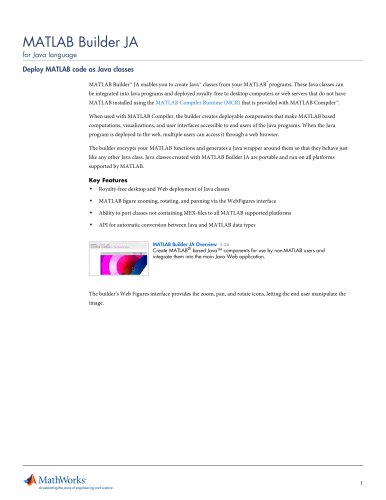
Catalog excerpts
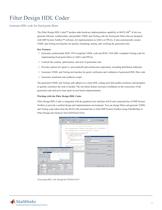
Filter Design HDL Coder Generate HDL code for fixed-point filters The Filter Design HDL Coder™ product adds hardware implementation capability to MATLAB . It lets you generate efficient, synthesizable, and portable VHDL and Verilog code for fixed-point filters that are designed with DSP System Toolbox™ software, for implementation in ASICs or FPGAs. It also automatically creates VHDL and Verilog test benches for quickly simulating, testing, and verifying the generated code. ■ Generates synthesizable IEEE 1076 compliant VHDL code and IEEE 1364-2001 compliant Verilog code for implementing fixed-point filters in ASICs and FPGAs ■ Controls the content, optimization, and style of generated code ■ Provides options for speed vs. area tradeoffs and architecture exploration, including distributed arithmetic ■ Generates VHDL and Verilog test benches for quick verification and validation of generated HDL filter code ■ Generates simulation and synthesis scripts The generated VHDL and Verilog code adheres to a clean HDL coding style that enables architects and designers to quickly customize the code if needed. The test bench feature increases confidence in the correctness of the generated code and saves time spent on test bench implementation. Working with the Filter Design HDL Coder Filter Design HDL Coder is integrated with the graphical user interface (GUI) and command line of DSP System Toolbox to provide a unified design and implementation environment. You can design filters and generate VHDL and Verilog code either from the MATLAB command line or from DSP System Toolbox using FilterBuilder or Filter Design and Analysis Tool (FDATool) GUIs. jaia *g*ftaaiiii:Eh||&a£ia|| +1m ^fou^iftgta all Generating HDL code through the FDATool GUI. Accelerating the pace of engineering and science
Open the catalog to page 1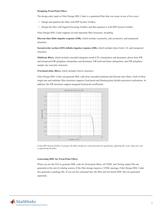
Designing Fixed-Point Filters The design entry input to Filter Design HDL Coder is a quantized filter that you create in one of two ways: ■ Design and quantize the filter with DSP System Toolbox ■ Design the filter with Signal Processing Toolbox and then quantize it with DSP System Toolbox Filter Design HDL Coder supports several important filter structures, including: Discrete-time finite impulse response (FIR), which includes symmetric, anti-symmetric, and transposed Second-order section (SOS) infinite impulse response (DIR), which includes direct form I, II, and transposed Multirate...
Open the catalog to page 2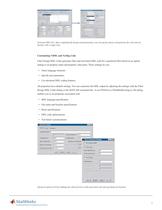
Generate HDL GUI. After completing the design and quantization, you can specify options and generate the code and test benches with a single click. Customizing VHDL and Verilog Code Filter Design HDL Coder generates filter and test bench HDL code for a quantized filter based on an option setting or on property name and property value pairs. These settings let you: ■ Name language elements ■ Specify port parameters ■ Use advanced HDL coding features All properties have default settings. You can customize the HDL output by adjusting the settings with the Filter Design HDL Coder dialog or the...
Open the catalog to page 3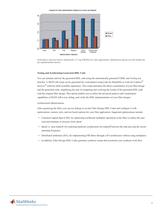
Impact of Code Optimization Options on Area and Speed Linear CSD Tree Pipelined CSD & Factored-CSD Pipelined & Pipelined Optimization Options Performance and area metrics obtained for a 27 tap FIR filter for video applications. Optimization options provide insight into Testing and Synthesizing Generated HDL Code You can simulate and test the generated HDL code using the automatically generated VHDL and Verilog test benches. A MATLAB script can be generated for cosimulation using Link for ModelSim or Link for Cadence Incisive software (both available separately). This script automates the...
Open the catalog to page 4
ModelSim simulation results of the fifth-order Butterworth filter and the original filter specification results from DSP System Toolbox. Automatically generated ModelSim test benches simplify and speed up the testing and verification of the VHDL and Verilog code generated by Filter Design HDL Coder. Resources Product Details, Examples, and System Requirements www.mathworks.com/products/filterhdl Online User Community www.mathworks.com/matlabcentral Trial Software www.mathworks.com/trialrequest Training Services www.mathworks.com/training Sales www.mathworks.com/contactsales Third-Party...
Open the catalog to page 5All The MathWorks catalogs and technical brochures
-
MATLAB Production Server
6 Pages
-
Database Toolbox
4 Pages
-
MATLAB Report Generator
4 Pages
-
Stateflow
8 Pages
-
SimEvents
7 Pages
-
SimDriveline
7 Pages
-
SimHydraulics
7 Pages
-
SimPowerSystems
8 Pages
-
Simulink Control Design
5 Pages
-
Aerospace Blockset
5 Pages
-
SimRF
6 Pages
-
Simulink Coder
6 Pages
-
Embedded Coder
8 Pages
-
Simulink PLC Coder
4 Pages
-
Fixed-Point Designer
9 Pages
-
MATLAB Coder
5 Pages
-
Simulink 3D Animation
10 Pages
-
Gauges Blockset
2 Pages
-
Simulink Report Generator
3 Pages
-
Polyspace Bug Finder
6 Pages
-
global-optimization-toolbox
10 Pages
-
Phased Array System Toolbox
9 Pages
-
OPC Toolbox
5 Pages
-
Simulink Design Verifier
7 Pages
-
Simulink Design Optimization
10 Pages
-
Bioinformatics Toolbox
9 Pages
-
SimBiology
6 Pages
-
Computer Vision System Toolbox
10 Pages
-
DSP System Toolbox
11 Pages
-
Fuzzy Logic Toolbox
5 Pages
-
Polyspace Client for C/C++
5 Pages
-
xPC Target
5 Pages
-
SimMechanics
7 Pages
-
Simscape
7 Pages
-
Simulink
6 Pages
-
Data Acquisition Toolbox
8 Pages
-
Image Processing Toolbox
7 Pages
-
Signal Processing Toolbox
10 Pages
-
Control System Toolbox
6 Pages
-
Symbolic Math Toolbox?
6 Pages
-
Parallel Computing Toolbox?
7 Pages
-
MATLAB®
6 Pages
-
Mapping Toolbox 3.2
7 Pages
-
Instrument Control Toolbox
7 Pages
-
Optimization Toolbox 6.0
14 Pages
Archived catalogs
-
MATLAB Release Notes
505 Pages
-
C and Fortran API Reference
263 Pages
-
External Interfaces
649 Pages
-
Function Reference: Volume 3 (P-Z)
1696 Pages
-
Function Reference: Volume 2 (F-O)
1568 Pages
-
Function Reference: Volume 1 (A-E)
1298 Pages
-
Creating Graphical User Interfaces
520 Pages
-
3-D Visualization
212 Pages
-
Graphics
667 Pages
-
MATLAB Programming Tips
66 Pages
-
Programming Fundamentals
840 Pages
-
Data Analysis
220 Pages
-
Mathematics
316 Pages
-
MATLAB® Getting Started Guide
250 Pages



